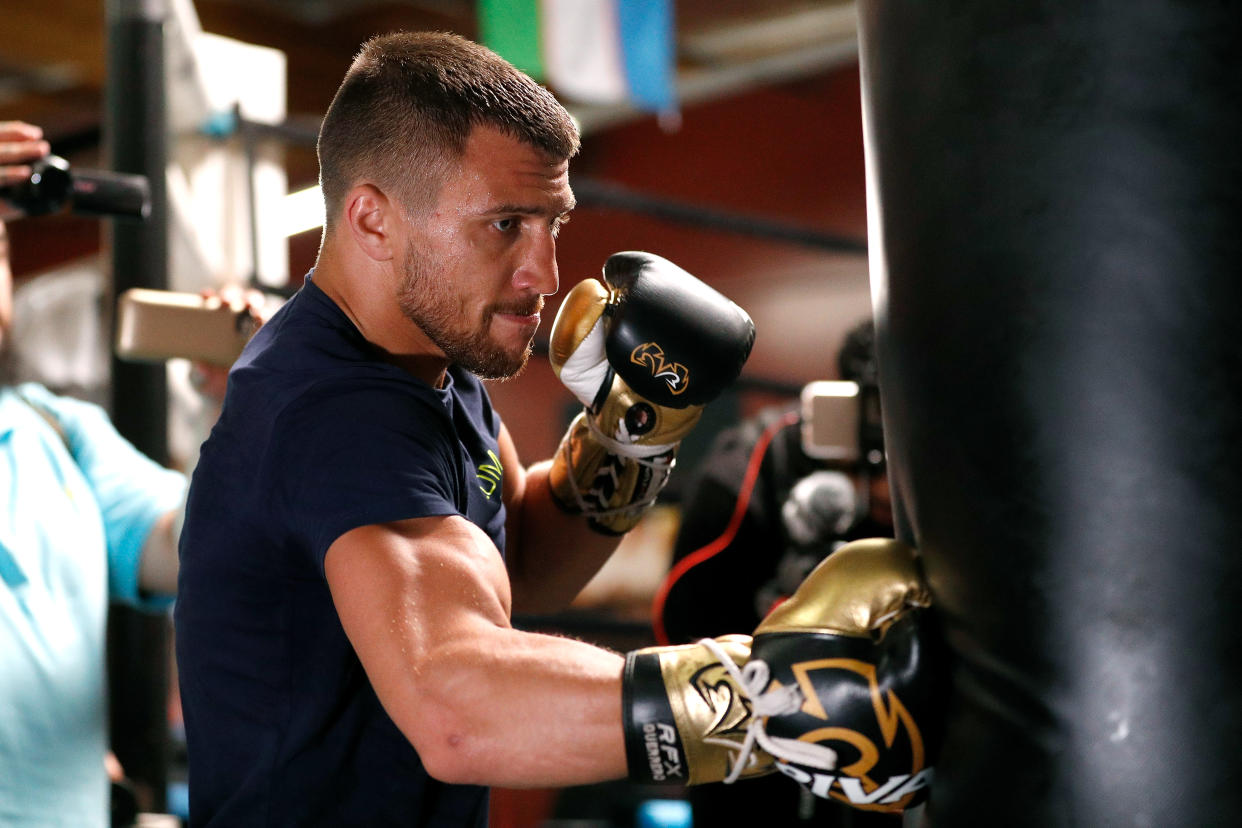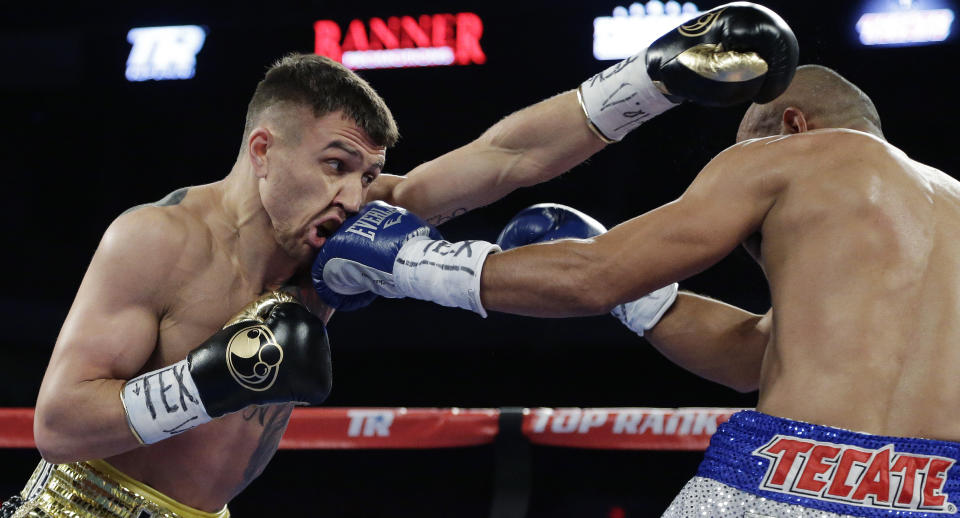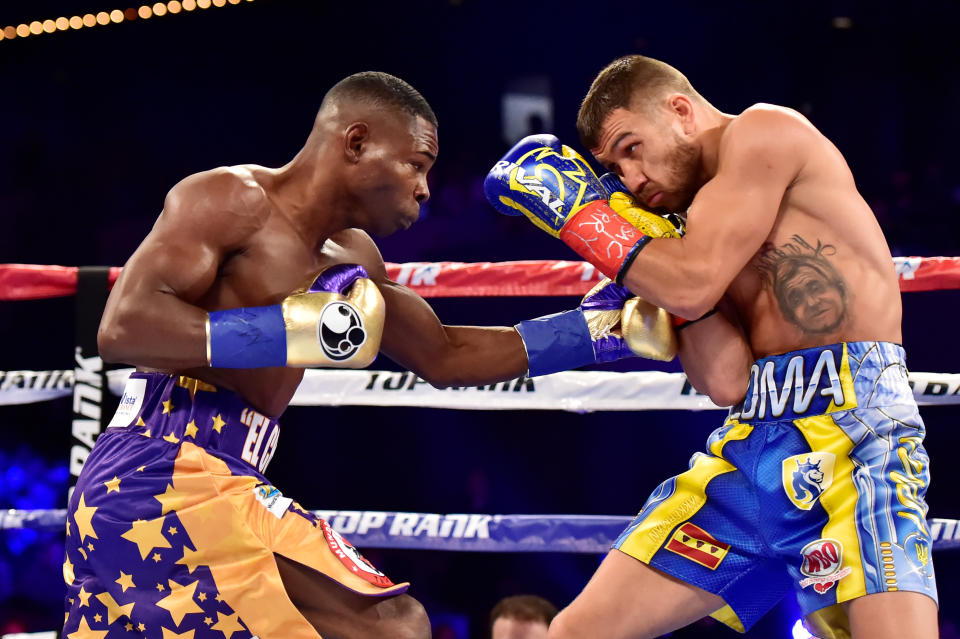Why Vasiliy Lomachenko is an anomaly among professional boxers

Boxing promoters often feed their top prospects low-level opponents almost up until they’re ready to fight for a world title, and sometimes even after they win a championship.
Now while records can be deceiving in boxing, it’s astonishing that Vasiliy Lomachenko’s opponents in the first 12 bouts of his professional career, including Saturday’s lightweight title fight against Jorge Linares at Madison Square Garden in New York, had a combined record of 353-30-12 at the time he faced them.
Lomachenko (10-1, 8 KOs) has faced three fighters (Gary Russell Jr., Nicholas Walters and Guillermo Rigondeaux) who had zero losses at the time he fought them. Five others (Suriya Tatakhun, Gamalier Rodriguez, Roman “Rocky” Martinez, Jason Sosa and Miguel Marriaga) had either one or two losses when they met.
What is perhaps most remarkable is that the one fighter who beat him, Orlando Salido, accounts for 40 percent of the losses and 25 percent of the draws on Lomachenko’s opponents’ records.
That was a split-decision fight in the second pro bout of Lomachenko’s pro career in March 2014, which promoter Bob Arum candidly admits Lomachenko wasn’t ready for. But Salido missed weight – some believe intentionally – and repeatedly fouled Lomachenko, though many experts who saw the fight believe Lomachenko deserved to win regardless.

Now, he’s heading into his 12th pro fight and gunning for Linares’ WBA lightweight title, which would be the third weight class in which he’s won a championship already.
Even for a veteran like Arum, who has promoted boxing for more than a half-century, it’s jaw-dropping what he’s doing.
“I’ve done this a long time and he hasn’t had those tomato cans that you usually feed to the guys as you’re building them,” Arum said. “He didn’t get those four- and six-rounders who really don’t have a shot to win the fight. He was fighting real guys from the beginning.”
But for as much as he has accomplished in his young career, Lomachenko is not satisfied. Few others in professional boxing share his attitude of wanting to fight the best at all times.
There are boxing politics to consider, and television-network affiliations frequently keep fighters from meeting in the ring. And so, despite all of the elite fighters Lomachenko has faced – six of his first 11 opponents have been world champions, and Linares (44-3, 27 KOs) will become the seventh in 12 fights – he isn’t satisfied.
“I am not interested in regular bouts, and just taking a guy because he’s available to fight,” Lomachenko said. “I want my bouts to be competitive and challenging and I’m always looking for the best opponent I can find.
“I haven’t always gotten the best. I know that. But the guys I’ve fought, they were the best guys who were available at the time. The stronger opponents, the better opponents, they maybe didn’t want to fight at the time or they were with a different network or a different promoter, and so it didn’t happen. You can only fight those who say yes and accept a fight, so I have fought the best I could get.”
When Lomachenko left the amateurs as a two-time Olympic gold medalist and with a 396-1 amateur record, he told promoters who were recruiting him he wanted to fight for the world title in his first bout.
The rules of the sanctioning bodies prevented that from happening, but Arum was able to arrange it for his second fight, when he challenged Salido for the WBO featherweight title in his next bout.
And though the match was close, Arum said it helped Lomachenko develop.
“Before that fight, they were so concerned about whether he had the ability to go 12 rounds, particularly at the pace that fight might have been at,” Arum said. “They’d never done anything remotely close to that before. Instead of concentrating on the fight and being as prepared as possible, they were really concerned mostly with being able to go 12. As it turned out, it wasn’t really a problem. But I remember when I got into the ring and [manager] Egis [Klimas] came up to me and said, ‘They said we couldn’t go 12 and we did.’ That was foremost in their minds in that fight.
“After he did that, he knew that would never be a problem for him and he’s just gotten better and better.”
He blew out Gary Russell Jr. in his next outing to win a version of the featherweight title and hasn’t looked back since.

Lomachenko thinks the fight with Linares will be far more fan friendly than his December win over Rigondeaux was, because Linares is an attacking, offensive fighter. Rigondeaux, by contrast, is a defensive-first fighter whose primary goal is to slow the fight down and avoid contact.
Despite being an elite offensive fighter, Lomachenko has a very simple reason why he focuses significantly on defense in training. It’s his defense, in many ways, that sets up his great attack.
“I don’t like to get hit in the head,” Lomachenko said. “It’s not a pleasure, I’ll tell you that. So I am trying to do my best to learn to be the best defensively I can be because that minimizes that risk.
“There are risks in this sport because of the kind of sport it is, but you have to be smart when you’re in there and you put yourself in the best position if you’re not getting hit in the head all the time.”
It’s Lomachenko doing most of the hitting in the head, which is why each of his last four opponents have quit in the ring.
It’s all part of building a long-term legacy. It’s why he plans to attend the Boxing Writers Association of America’s gala in New York on Friday, the night before he fights Linares, to accept the Fighter of the Year award from the organization.
“Boxing history is important to me and it’s a big pleasure for me to be recognized like this because it all adds to my legacy,” he said. “When I am finished, all things like this will add up and people will discuss [it]. I want to put my name in boxing history and you have to go above and beyond to try to do that.”
More from Yahoo Sports:
• Tom Brady turns heads at Met Gala with unorthodox tuxedo
• Terez Paylor: The ripple effects of Matt Ryan’s $150M deal
• Ex-Duke star’s mom: NCAA model is like ‘slavery’
• Report: NASCAR owners exploring selling whole sport


